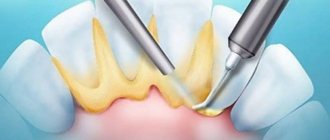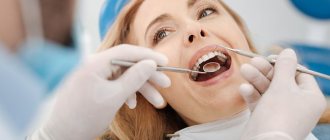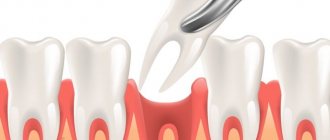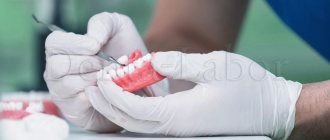Why plaque and stone are dangerous
The plaque that settles on the teeth is soft. It can be easily removed with any hygiene products. Within 6-12 hours it reacts with the components of saliva, becomes saturated with calcium salts and hardens. The only way to prevent this is to use mouthwash throughout the day. Once the plaque has hardened, it can no longer be removed.
Tartar gradually forms. It continues to grow as new layers of plaque easily “stick” to the rough surface. After about 6 months it becomes visually noticeable, but this is not its main danger.
The stone grows in the cervical part of the crown, gradually penetrating into the subgingival area. This leads to mechanical damage to the gums and loosening of the teeth. Microorganisms cause gum inflammation and provoke more severe oral diseases. Patients complain of bleeding and sensitivity of the gums, and bad breath. With further growth of the stone deeper into the gums, there is a risk of developing cysts on the root of the tooth.
Causes of plaque formation
- Irregular or improper care, lack of timely removal of food debris;
- Predominance of carbohydrates in food;
- Low chewing activity;
- Pathologies of the digestive system;
- Individual characteristics of saliva composition.
Signs of deposits:
- There is no shine on the enamel;
- The texture of the enamel changes and becomes rough;
- Darkening of the enamel is noticeable in certain areas.
At first the coating is white, but over time it changes color to yellow, then acquires a brownish and even greenish tint. These deposits are noticeable from the outside and do not look aesthetically pleasing.
If you do not take cleansing measures:
- An unpleasant odor appears;
- The area where plaque accumulates is expanding;
- The enamel surface becomes rough.
In people who frequently drink coffee and tea, as well as in smokers, the plaque becomes dark and difficult to remove.
Causes of congestion
- Insufficient oral hygiene, incorrectly selected hygiene products.
- Eating a lot of sweets, sticky foods, rich in light carbohydrates, and at the same time a small amount of solid foods, such as vegetables, in the diet.
- Abuse of products that have a coloring effect. Tea, coffee, cola, carbonated drinks - all this leads to the fact that the plaque turns brownish and, after hardening, spoils the smile.
- Diseases of internal organs. Patients with diseases of the gastrointestinal tract and endocrine system are prone to the formation of plaque on their teeth.
- Partial edentia, malocclusion, severe crowding of teeth.
Patients with bridge prostheses are at risk. The bridge is fixed on the supporting tooth. Food particles get trapped under the crown. In this case, cleaning plaque on teeth with conventional means is impossible. As a result, it grows, microorganisms attack the gums and supporting teeth, and it becomes mobile. If you have dentures, you should definitely visit your dentist for professional cleaning.
Teeth cleaning from tartar in the clinic
In dentistry, to remove tartar, you can use the service of professional teeth cleaning (or professional oral hygiene). This service is available in almost all dental clinics. Several professional methods are used to remove tartar:
- Ultrasonic cleaning. This is the most accessible and widespread method. The doctor uses a special device - a scaler. It creates low-frequency vibrations that gently peel away hard deposits from the enamel. The doctor then uses water and air pressure to cleanse the mouth. Ultrasound is suitable for both supragingival and subgingival deposits. This method is safe for enamel and gums. At the end of the procedure, the dentist polishes and fluorides the teeth to reduce sensitivity and strengthen them.
- Laser cleaning. The procedure is similar to ultrasonic cleaning, the only difference is in the device used. Laser is considered a more modern method, effective and safe. The advantage of this method is that the laser promotes rapid gum regeneration and has an antibacterial effect.
- Air Flow. A modern way to clean the mouth. More expensive compared to the first two options. For cleaning, the doctor uses a pressure consisting of water, air and sodium carbonate. This method differs in that in addition to removing tartar, the enamel is also lightened.
There are also options for chemical and mechanical cleaning, but due to their traumatic nature and low efficiency, modern clinics do not use them.
Types of plaque
- Soft. Formed on teeth during human life. It is not noticeable on the surface of the enamel and is easily removed from it using hygiene products.
- Solid. Once hardened, it is almost impossible to remove plaque from teeth at home.
- Supragingival stone. Formed from hard plaque. Outwardly it looks like a small dark-colored rim in the cervical area.
- Subgingival stone. It is formed under the gum, so it is not visually noticeable. It can only be detected using a special dental probe or an x-ray. If subgingival stone is not removed in time, gum resection may occur.
Lemon, celandine and soda
On the Internet you can find many articles with headings from the series “how to clean tartar at home” or “how to dissolve tartar at home.” In these materials you can find dozens of “one hundred percent” recipes that will miraculously help get rid of tartar. In fact, all this is a myth. No traditional medicine can effectively remove hard dental plaque. Moreover, most of these tinctures and decoctions can also cause harm. For example, a decoction of celandine (often recommended) is poisonous and can cause poisoning. Lemon juice, which is a component of most of these recipes, contains acid, which is generally harmful to dental tissue and is ineffective at removing hard deposits.
To summarize, there is more harm from such recipes than good. The only more or less effective remedy, whose chemical properties help to somehow break down small dental deposits, is a solution of soda and hydrogen peroxide. At the same time, the same peroxide (especially if you make a mistake with the proportions) can cause serious harm to the enamel, so you can use it only at your own peril and risk.
Home Remedies
Home remedies for plaque removal are rather preventative. In order to maintain dental health, it is necessary to follow the rules of hygiene:
- Brush your teeth twice a day with a toothbrush and suitable toothpaste.
- Use toothpicks and dental floss after meals, as the brush cannot reach hard-to-reach places.
- Use mouthwash regularly.
Small plaque can be removed using pastes containing abrasives or tooth powder. When using them you need to be careful, as you can damage not only the enamel, but also the mucous membrane of the gums. You need to be even more careful if you decide to remove plaque from your teeth with whitening agents - soda, hydrogen peroxide. Their uncontrolled use can cause problems with dental health.
Alternative Methods
Peroxide is not always effective, so there are a number of alternative recipes that enhance its effect on tartar. Let's take a closer look at how to remove tartar using hydrogen peroxide and auxiliary components.
| Auxiliary Component | How to cook? | How to use? | Duration of use |
| Soda | Take a tablespoon, put half of the baking soda in it and add 3-4 drops of peroxide to make a plastic mass | Apply a large pea-sized amount of product to your toothbrush and clean your teeth thoroughly, paying special attention to chewing teeth. | 2 times a month |
| Oak bark | Grind 1 tablespoon of oak bark in a coffee grinder to a powder. Add a few drops of peroxide to make a thick paste | Apply the product to your toothbrush and go over all your teeth. This composition is especially good for gums, as it helps strengthen and destroy pathogenic flora. | 2-3 times a week, preferably at night |
| Sage and lemon | Grind a teaspoon of sage herb in a coffee grinder, add 5 drops of lemon juice and the same amount of peroxide | Apply the product to a cotton swab and apply it to your teeth, press lightly and hold for 3 minutes, then rinse your mouth with warm water. | 1 time per month |
Dozens of other ways to get rid of tartar are listed in our large selection.
Using peroxide, you can remove not only stones from teeth, but also from dentures. To do this, place the removable structure in a container with peroxide for several minutes, let it stand, and then clean it well with a stiff toothbrush. If you do this procedure several times a month, the dentures will be in perfect condition.
Note! Hydrogen peroxide cannot be used to replace regular hygienic toothpaste, as it will not give the desired effect. On the contrary, there is a risk of gums softening, which will lead to increased bleeding and premature receding.
We hope that our recommendations were useful, and now you know how to remove tartar with hydrogen peroxide. The procedure, you see, is not complicated, but precautions must be observed. If you doubt the effectiveness of the method, it is better to consult a specialist before using it. Perhaps peroxide specifically in your case will do more harm than good, and the stone will be removed using other methods.
Tags: at home, tartar, folk remedies, hydrogen peroxide, step-by-step instructions
About the author: DrZubastik
- Related Posts
- Activated carbon for teeth whitening: following the recipe of Russian beauties
- Rules for teeth whitening with banana peel
- How to get rid of caries at home?
« Previous entry
What is tartar
Tartar is hardened soft plaque. When brushing teeth incorrectly or poorly, a soft mass consisting of fragments of the mucosal epithelium, food particles and colonies of bacteria accumulates on their surface and in the interdental spaces. Under the influence of saliva and substances produced by bacteria, the mass gradually hardens, turning into tartar. Hard deposits may be observed on the back surfaces of teeth and between teeth, in which case they are classified as supragingival calculus. Gradually, under the influence of gravity and chewing movements, the stones move under the mucous membrane of the gums and are classified as subgingival.
Prevention of tartar formation
The only reliable and effective means of prevention is control over the quality and regularity of dental and gum care.
Be sure to brush your teeth at least 2 times a day (morning and evening), ending each procedure with the use of an irrigator. This will help remove soft plaque from areas that traditional oral hygiene products cannot reach.
In addition, it is important to monitor your overall health, promptly seek bite correction and minimize the consumption of fast carbohydrates such as baked goods, sweets, etc.
More detailed information is presented in the catalog of oral irrigators.
Classification of plaque by location
- Deposits on visible surfaces where they can be easily removed;
- Plaque under the gum (in the pocket) requires professional hygiene and causes inflammatory processes.
Plaque is diagnosed independently - local changes in the color of the enamel can be seen by looking in the mirror.
If the deposits are minor or are located in hard-to-reach places, they can be diagnosed with special substances that color the plaque.
Preventive visits to the dentist will help keep your mouth clean. Only a specialist can identify the problem in a timely manner.
Comments
I had my teeth cleaned at the dentist for the first time in my life just a few months ago, and today I noticed that there was too much plaque again. How so??
Olga (02.09.2020 at 20:39) Reply to comment
- Dear Olga, the rate of plaque formation can be affected by the presence of chronic diseases, poor oral hygiene, smoking, consumption of “colored” foods and drinks, the presence of gingivitis and periodontitis. Sometimes the cause of the pathology is the unprofessionalism of the doctor, who poorly polished the surface of hard tissues at the final stage of cleaning. You should contact an experienced dental hygienist or dental therapist to understand the situation.
Editorial staff of the portal UltraSmile.ru (09/06/2020 at 09:15) Reply to comment
I have an “extended” tooth, but it has become darker than mine, the doctor explained that a change in color can occur over time. Is it possible, in addition to a crown, to achieve lightening of just such a tooth?
Mira (09.23.2020 at 07:15) Reply to comment
Tell me, if you have crowns in visible places and your own teeth, what is best to use for cleaning? That is, the listed products for home use are also suitable for cleaning crowns. Or is there something simpler for crowns, or vice versa more effective?
Inga (09.23.2020 at 09:00) Reply to comment
Tell me, which method of professional teeth cleaning is the safest and most gentle? And what is the most correct and effective method of home cleaning? I'm afraid of ruining the enamel.
Elena (09/23/2020 at 11:57 am) Reply to comment
We were surprised about the banana peel! I knew about fruit acids. I have increased sensitivity of all my teeth, because my gums have risen, if I express myself correctly, that is, the necks of my teeth have become slightly open. Visually it’s not very noticeable, but there is a reaction to sweet/sour. In my case, there’s probably no way to whiten my teeth at all? Thank you.
Victoria (09/23/2020 at 12:32 pm) Reply to comment
Twice a year I do ultrasonic teeth cleaning. The dentist advised me to buy an electric ultrasonic toothbrush. But I heard that electric brushes destroy teeth. Is it worth buying?
Zlata (11/20/2020 at 6:10 pm) Reply to comment
Hello, can you tell me how often I can do water-abrasive cleaning? If six months have not yet passed since the last procedure, and I am still not satisfied with the cleanliness of my teeth, can I repeat the procedure, or will frequent use harm my teeth?
Irina (11/20/2020 at 6:59 pm) Reply to comment
Doesn’t all this cleaning harm the enamel and make the teeth, although plaque-free, sensitive? I'm afraid to even do regular brushing; I think I could damage my teeth or wear away the enamel.
Sveta (11/20/2020 at 07:41 pm) Reply to comment
I don't smoke, but I still have plaque. I drink a lot of coffee, so they are yellow. I used to brush with baking soda instead of tooth powder. Then they told me that I shouldn’t do this often because it could erase the enamel.
Anna (11/20/2020 at 08:29 pm) Reply to comment
A high-quality paste will help you and it’s expensive, and after one brushing I also clean it with tooth powder. Those. twice a morning, for example. Well, you also don’t need to overdo it with cleaning, so that you don’t have a dry mouth later.
Marina (11/20/2020 at 09:08 pm) Reply to comment
Write your comment Cancel reply
What are the dangers of tartar?
In cases where tartar has already formed, treatment should be carried out immediately. Otherwise, it moves under the gums and leads to severe disorders of tissue metabolism in soft tissues.
As a result, acute or chronic gingivitis develops, the ligamentous apparatus of the tooth becomes inflamed and, as the most severe complication, periodontal disease develops - atrophy of the tissues that provide support to the tooth. As a result, a person who has developed subgingival tartar in the future faces the need to remove teeth that have lost stability and are no longer able to perform their functions.











